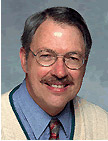(See Projects story on the Composite
Truck Box.)
Where are you from?
I was born in Enid, Oklahoma, where my father was a professor
at Phillips University. Then we moved to Emmaus, Pennsylvania,
where I grew up. My father taught nearby at Moravian College
in Bethlehem.
Why did you study chemistry?
Around the time that I was finishing high school and starting college at Moravian, I decided I was interested in science. I took chemistry and stayed in the field. I went across town to Lehigh University for my Ph.D. and then was fortunate enough to end up here.
Were you interested in working in the automotive industry?
I wasn't specifically looking at the automotive industry, but I was interested in working in research.
What was your first assignment at GM R&D?
My very first project was to study high-speed curing of wire coating. At that time, GM made most of the wire used in its vehicles. You had to cure and cross-link it, so it wouldn't melt and drip off in the heat of the engine.
Then I worked on polymer blends to improve the properties of plastic materials by incorporating other materials into them. But instead of using chemical reactions, we focused on blending and mixing.
Later, I became more involved in reactive polymers. For example, I worked in the lab on variations of the RIM material we used for the truck box. With a background in the RIM technology, I became part of the technical team when the composite pickup box project began.
How did that evolve?
In the beginning, our team worked quite a bit on evaluating materials, both those supplied directly from vendors and combinations we put together. As the project progressed, work moved to an outside location and we became the technical advisory team.
The possibilities seem never-ending ...
That's for sure. I think the field of Plastics is growing. There's more and more need for plastic parts and the strength is just going up and up.
Were you excited that the results of your work ended up on a production vehicle?
Definitely. I think that researchers always hope that projects they work on will end up in the showroom and in the public's hands.
Are you continuing to work in the area of composites?
Yes, I'm focusing on a couple of projects. In the lab here, I'm working on a program to make composites with improved appearance, so that we can put them on the shiny part of the vehicle. The truck box has a grain finish, with more of a matte look.
I'm also involved with the Automotive Composites Consortium. In that activity, I'm working with a team that's looking at processing of carbon composites. The technology is similar to that used for the truck box but for still lighter weight materials. This pre-competitive work is a joint project of Ford, Daimler Chrysler, and GM.
How will the carbon composites be used?
They will be the main structure and body shell of the vehicle. We're building a generic vehicle not related to any one of the three companies involved. I'm working specifically on processing and molding, because carbon behaves differently from glass fiber when you mold it. Also, we're trying to build much thinner panels to make use of carbon's higher strength. Thin-panel molding is also a new step.
Ultimately, we hope to reduce the weight of the body structure about 60 percent over steel. That's a significant weight savings.
What excites you about your research?
It's not a game, but it's still fun to do. Each day, we have the potential to come up with something new.
Would you describe a typical day?
I don't really have one. As part of my work with the ACC, I attend a lot of meetings. For one project I worked on with them, I spent several days each month working off-site. Right now we're in the process of formulating a new project, so we have both general meetings and smaller group meetings.
When I'm at R&D, I try to answer messages, then get into the lab. If the technicians are working through an assignment list, I just check to see how things are going and offer suggestions. When we're starting something new, I work with them. That will often continue through the morning and early afternoon. Later in the afternoon, I analyze data and put together reports.
I'm also in the process of designing and building new equipment for my lab, so working with suppliers takes up much of my time right now.
What do you do when you're not working?
The house, the lawn, the garden. I also spend a significant amount of time working with a community theater group. I try to play a role in one show each year and work backstage, designing and building sets, for other shows.
You're particularly proud of your set designs, I understand ...
Some of my sets have come out really well, I think - in fact, the local reviewer once mentioned the stage design before critiquing the production! I also play supporting roles in musicals. Two I particularly enjoyed were The Pirates of Penzance and Carousel. I like it, because it's a complete diversion from what I do at work.




